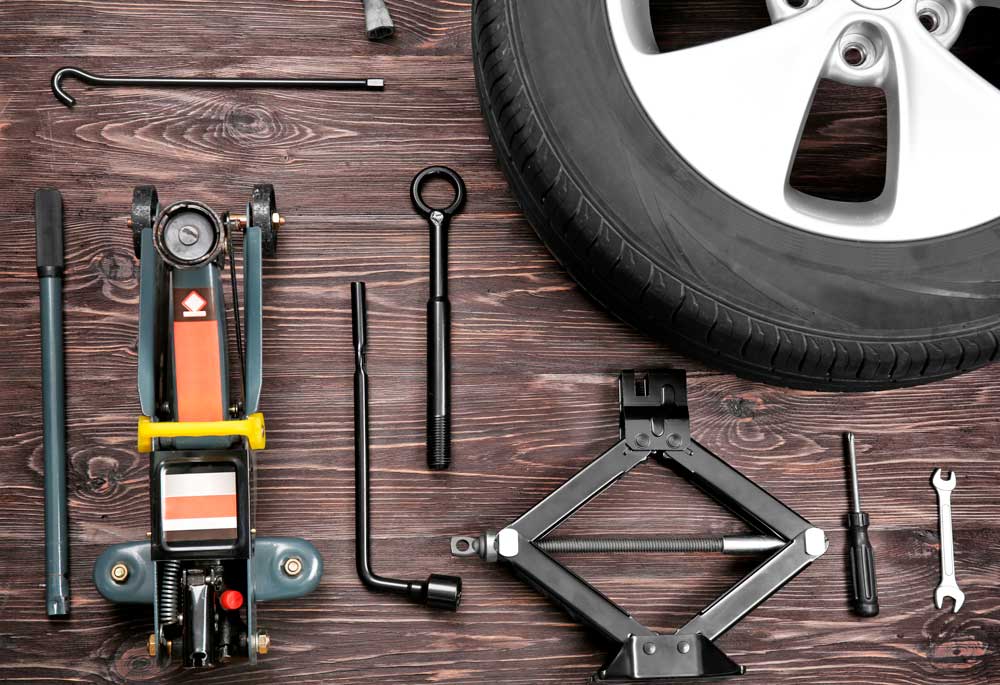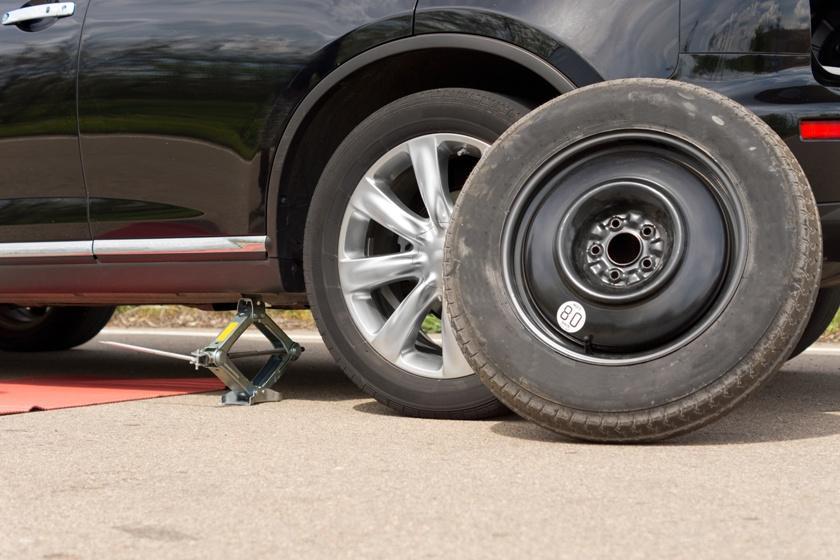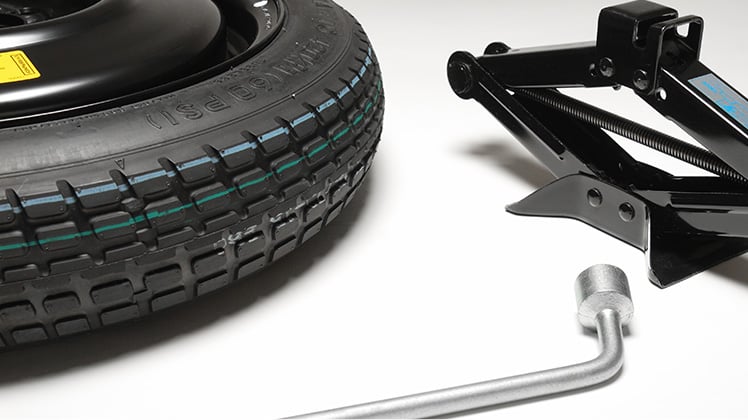The CarHub Guide to Changing a Car Tire
Posted on April 8, 2021
CarHub's Complete Guide to Changing a Car Tire
Modern cars are very efficient. Many people drive their whole lives without learning the basic skills to fix them when needed. You might think, "I have a cell phone; I'll just call CAA."
But what if your phone doesn't work because you're out of range or out of battery? Knowing how to change a tire ensures you can get back on the road if an accident happens.
No car is perfect, and even the best can have issues. And knowing how to change a tire can save you from being stuck if you get a flat. It's a simple skill that can prevent a lot of headaches.
With regular car maintenance from a CarHub licensed technician, car tire blowouts should be few and far between. They can still happen though. Don’t worry, in our long line of car maintenance tips, we’ve decided to include a guide to changing tires, just for your benefit.

When Do You Change Tires on a Car?
It is ideal to replace your tires when the option is to do it and not when you must do it. If they get frayed, damaged, or look like they are about to give in, then one should replace them. Make sure your replacements have the same tire rating in type and style as the one indicated on the car wall.
The first and probably one of the most apparent occasions that require changing of a tire is when one acquires a flat.
How Long Does It Take to Change a Tire?
Practice makes perfect! Try changing a tire in your driveway a few times so you're prepared for real-life situations. Even for beginners, the process should be quick. If everything goes smoothly, a tire change should take between 15 and 30 minutes.
How To Change a Car Tire?
Changing a car tire is a basic skill that every driver should master. Following a few simple steps, you can safely replace a flat tire with a spare and get back on the road quickly.
1. Best Tools for Changing a Car Tire
To change a tire, you'll need a few essential tools. Fortunately, these are items most people already keep in their vehicles. The best tools for changing a car tire include:
- a tire jack
- a lug wrench
- a fully inflated spare tire
- your vehicle's owner's manual
To quickly take roll-check of the car, please observe the following to confirm that you have the following items. If any one of them is lost or damaged, it is to be replaced without any delay. These tools described here will come in handy to you and ensure that you are ready for any incident that might happen.
Make sure you always have a usable spare tire by checking the tire pressure to the correct PSI. If you ever find yourself using the regular tire check, don’t ignore the spare tire; ensure you check it as well.
2. Choose a Safe Spot
When you get a flat tire, prioritize safety. Avoid abrupt stops or turns. Instead, slow down and look for a flat, level area with a wide shoulder. This will prevent your car from crashing. Make sure your spot is visible to oncoming traffic, avoiding curves where drivers may not see you.
Finding a safe place to change your tire is crucial. While driving on a flat tire can damage your rim, it's better than parking in a dangerous spot.
3. Activate Your Hazard Lights
When you notice a problem, immediately turn on your hazard lights. Reduce your speed to alert other drivers to your situation, ensuring they give you space and can help if needed.
4. Secure Your Wheels and Parking Brake
Make sure your vehicle stays put by applying the parking brake immediately upon stopping. Wheel wedges placed in front or behind your tires will further prevent any rolling while you work on your car. Taking these precautions is essential for safety.
5. Taking Off the Hubcap or Wheel Cover
If your vehicle has a hubcap, it's best to remove it while the tire is still on the ground. Use the flat end of your lug wrench to pry it off. Some cars may need a specialized tool, which will be indicated in your owner’s manual.
If your vehicle has lug nuts, loosen them slightly.
6. Lift the Car with the Jack
To lift your car, place the jack beneath the frame next to the flat tire. Some cars have a designated jack point, usually marked with exposed metal. Check your owner’s manual for guidance on the best placement.
Ensure stability by placing the jack on the provided wood block from your kit. This prevents slipping or imbalance while lifting. Raise the vehicle about six inches off the ground, but never place any body part under the car while it's lifted, in case the jack slips.
7. Remove the Lug Nuts and the Old Tire
Now, finish loosening the lug nuts you started earlier. Once they're loose enough, you can unscrew them the rest of the way by hand. Once the lug nuts are off, pull the tire off the hub completely and set it aside.
8. Install the Spare Tire
Slide the spare tire onto the hub, aligning the rim with the lug bolts. Once aligned, hand-tighten the lug nuts in a crisscross pattern.. Wait to use the lug wrench until the car is lowered back to the ground.
Lower the vehicle until the spare tire touches the ground, but not the full weight of the car. Use the lug wrench or torque wrench to tighten the lug nuts clockwise with firm pressure.
Once the lug nuts are fully tightened, lower the car completely. Double-check the lug nuts to ensure they are secure before replacing the hubcap. If you can't replace the hubcap immediately, store it with your tire change kit.
Check the spare tire's pressure; if it's low, visit a service station to inflate it properly. Remember, drive cautiously as spare tires are not designed for high speeds.
9. Put Tools Back and Check Tire Pressure
Return the jack, lug wrench, and other tools to their storage places in your vehicle. Check the pressure of the spare tire using a pressure gauge. If needed, adjust the pressure to the recommended PSI.
10. Get the Flat Repaired
After installing the spare tire, it's essential to repair the flat tire as soon as possible. Contact a professional service for a proper repair or replacement of the flat tire to ensure it's safe for future use.
By following these steps, you can effectively change a car tire and get back on the road with confidence. Always prioritize safety and proper maintenance to keep your vehicle running smoothly.
Essential Tips for Changing Tires
Changing a tire is essential knowledge for any driver. Here are some additional tips to keep in mind:
1. Regular Maintenance
Besides knowing how to change a tire, regular tire maintenance is crucial. Check tire pressure regularly and keep them properly inflated to ensure optimal performance and longevity.
2. Rotate Tires
Follow the manufacturer’s guidelines for tire rotation to promote even wear and extend tire life. This practice can also help prevent unexpected flats due to uneven tread wear.
3. Monitor Tread Wear
Keep an eye on the tread depth of your tires. Balding or worn-out treads are more prone to flats and can affect vehicle handling and safety.
By incorporating these tips into your routine maintenance, you can reduce the risk of flat tires and ensure your vehicle’s tires perform reliably over time.
Knowing When Your Tires Need Replacement
Regular tire maintenance is crucial regardless of age. Bridgestone advises monthly inflation checks and regular professional inspections. After five years, you must assess the tire condition closely for safety.
Tires manufactured 10 years ago or longer, including spares, should be replaced even if they appear unused. However, tire replacement isn't solely about age; factors like tread wear, damage, and improper inflation can necessitate replacement sooner. Always prioritize safety over tire age alone.
Do I Need to Replace All Four Tires at Once?
Yes, it's generally recommended to replace all four tires simultaneously. Consistent tire performance is crucial for vehicle handling and safety. If replacing fewer than four tires, match the new tires closely to the existing ones.
Install new tires on the rear axle if replacing only two, and ensure they are within the same category as the originals. For vehicles with staggered fitment, consult the owner's manual for specific replacement guidelines.
Which Tires Are Better: New or Used?
Buying used tires comes with risks due to unknown histories, potential internal damage from previous use, and uneven wear that can cause noise or vibration.
New tires, recommended by your vehicle’s manufacturer for size, load capacity, and speed rating, offer reliability and peace of mind, ensuring safer driving conditions.
Let a Pro Handle the Rest
As soon as you can, let a service professional assess your tire situation. CarHub’s certified service technicians will be able to tell you if your damaged tire can be salvaged or should be replaced and they will be able to offer you insights into the health of your remaining tires.
Do you have questions about your tire health? You can book an appointment today at CarHub.ca to speak with a registered service technician about your tires and any other service concerns!



